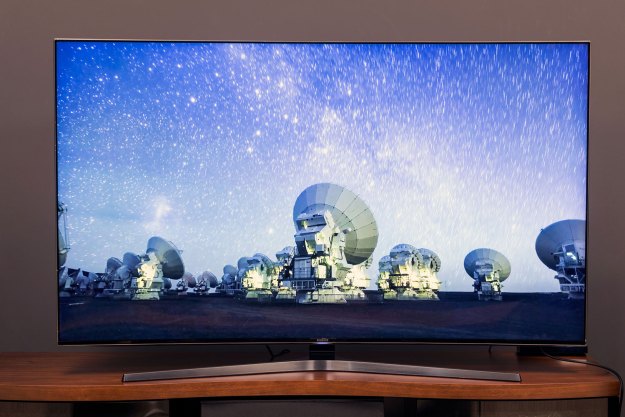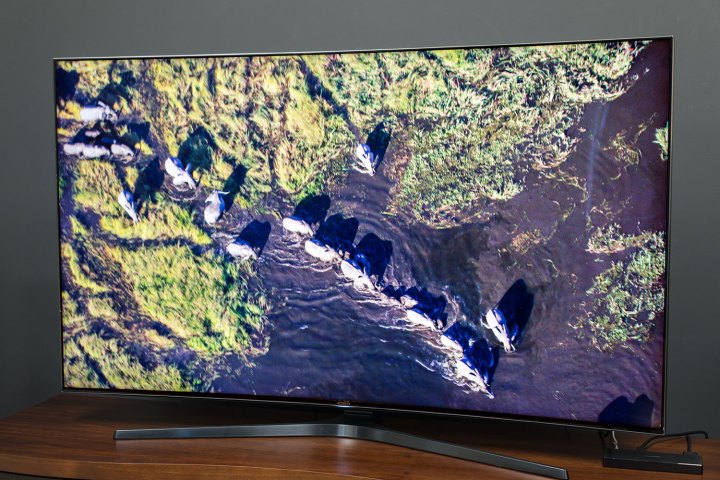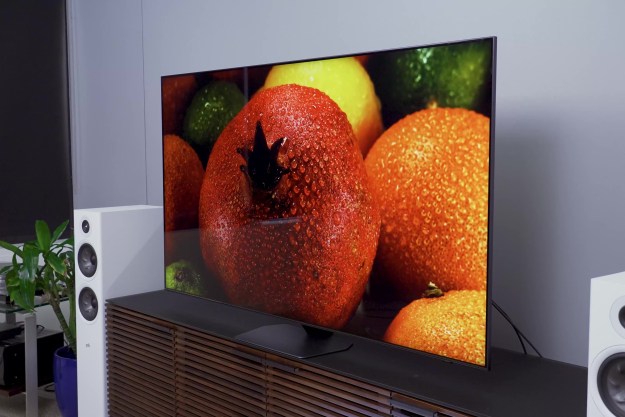
“Samsung's KS9800 offers stunning premium HDR, killer color, and deep blacks for a 4K Ultra HD picture like no other.”
- Outstanding HDR performance
- Impressive Black Levels
- Deep, rich color
- Excellent user experience
- Poor off axis performance (narrow viewing angles)
- Expensive
Reviewing TVs used to be a lot easier. Just a few years ago, plasma sets were known for their superior blacks, LEDs were known to be brighter and thinner; and the very best technologies were reserved solely for the flagship models from a select handful of manufacturers. As such, the chasm separating the good from the great was relatively wide and deep. That’s not the case any longer, and it’s made buying a TV just as challenging as reviewing one.
Today we have OLED TVs, FALD (full array local dimming), 4K UHD resolutions, HDR (High Dynamic Range), and WCG (Wide Color Gamut) to think about. I’ve always said you can judge a market’s complexity by the number of acronyms in its lexicon, and as you can see, the world of TVs has gotten pretty complicated.
At least we can still count on flagship TV models to set the high bar, and there is perhaps no better example of this than the Samsung KS9800 series which, while far from flawless, clearly displays the kind of picture quality we should expect in the future.
Out of the box
Unlike the ultra slim and light Samsung KS9500 we recently experienced, the KS9800 is a bit on the heavy side at 62.2 lbs. without its stand, and 69 lbs. with it. If you’re going to be setting this TV up yourself, make sure you have a friend around to help wrangle the TV out of the box and either wall mount or stand mount it.
From an aesthetic point of view, the KS9800 series is a very attractive TV – if you like the curve. Once again, we wish Samsung made a flat version an option rather than force anyone wanting its flagship to adopt the curve, but Samsung has taken a position on the curve and is sticking to it. For what it’s worth, we don’t think it does anything significantly good or bad for the picture quality.
Samsung has once again made great effort to keep the back of the TV looking as clean as the front by utilizing a shirring pattern on the back with clever panels that help hide the few cable connections that must be made. The set’s bezel is ultra-thin, and the curved stand is matte silver.
In the box with the TV you’ll find the TV and stand hardware, a One Connect Mini box (more on this later), and Samsung newest smart remote control.
The user experience
Samsung has packed more technology and features into this television than you can possibly imagine. Suffice it to say, Samsung isn’t only striving to deliver the best picture quality possible, it also aims to deliver the best possible user experience, and we think the company has done a pretty terrific job of it.
Samsung has packed more technology and features into this television than you can possibly imagine.
To simplify connecting source devices, Samsung has kept the One Connect box, but slimmed it down and simplified its operation, resulting in the newly named One Connect Mini. You still plug all of your devices into this one box, with just one cable running up to the television, but unlike the older One Connect box, the TV’s brains are no longer housed here, and, therefore, there will no longer be any One Connect box upgrades issued in the future.
It may seem odd that Samsung stepped its flagship TV’s processor back to a quad-core from the octa-core we saw on last year’s JS9500, but based on what we experienced with the KS9800’s Tizen operating system, performance hasn’t suffered. Navigation is snappy, and apps like Netflix load as quickly as ever.
Speaking of Tizen, it’s great to see Samsung evolving this platform into something that really works for people. The TV offers many thoughtful bonuses we think owners will love. For instance, when the Netflix app is highlighted along the ribbon at the bottom of the TV, all of the most recently played movies and TV shows — down to the most recent episode – pop up for immediate resumption. If there are multiple users on one Netflix account, the most recently logged in user’s shows will be shown, but switching users is extremely quick.
The KS9800 is also able to automatically detect and control myriad source devices, eliminating the need for numerous remotes or programming a universal remote. The TV can also learn commands fed to it by the user. Input sources will be specifically named for clear access, and the most commonly used sources will always appear first in the Tizen ribbon displayed at the bottom of the TV’s screen.
Samsung’s latest Smart Remote is certainly its simplest yet, with just a few buttons available for the most common controls, including power, volume, channel up and down, and a cursor pad for navigation and external device control. The remote system takes a little time to get used to, but once learned it is extremely easy. Normally, this is where we’d criticize the lack of backlighting for the remote, but with so few controls available, easily learned touch memory makes backlighting unnecessary.
With all of that said, we wish Samsung would have included a “standard” remote for those reluctant to give up on having buttons for each and every function they may wish to access. This has been Samsung’s standard practice up until now, and we’d hope the company may return to this standard next year.
Finally, the KS9800 does offer some voice control, but as you’ll see in our video, it isn’t as smart as we’d like it to be, and often no easier to use than a standard text search.
Under the hood
Samsung has thrown everything it has at this television, and that results in some stellar performance, which will get to in a moment.
The primary difference between the KS9800 and the step-down KS9500 is the flagship’s FALD (full array local dimming) backlight system, which allows the TV to offer better screen uniformity, much higher brightness with less halo effect, and better black levels. The KS98900 also gets a 10-bit panel outfitted with a quantum dot sheet which expands the TV’s color volume, adding more shades of color, and a broader range of color brightness as well. All of this is further accented by the TV’s HDR capabilities.
Samsung has thrown everything it’s got at this television, and that results in some stellar performance.
HDR10 (high dynamic range) processing is probably this TV’s best trick. Not only can the KS9800 achieve a claimed 1000 nits of peak brightness (for very short periods of time and only in small areas of the screen) HDR+ promises to make non-
For HDR content, you have a wide variety of content to choose from. Both Amazon and Netflix offer expanding catalogs of 4K Ultra HD content with
Performance
In many ways, the KS9800 is the finest TV Samsung has made to date, and the most dazzling, generally enjoyable TV Samsung has ever offered. That high praise comes with a rather significant caveat, however.
First the good: The KS9800 offers outstanding black levels, stunning spectral highlights with intense brightness, a modicum of halo around bright objects on dark backgrounds, and minimal backlight bleeding from the panel’s edges.
The recent reissue of JJ Abrams’ Star Trek on 4K Ultra HD Blu-ray with HDR dominated our evaluation time with the KS9800 as it was an already gorgeous film made better with the addition of
Those of us who have worn out the standard Star Trek Blu-ray instantly noticed the sparkle and unleashed color depth present in the 4K Ultra HD version. Changes to the shades of red on the Enterprise deck were easily distinguishable, and did a good job of showing off the KS9800’s expanded color pallet. Not only was the shade different, but the brightness of key colors helped the image to pop off the screen.
Spectral highlights were also expertly delivered, although a little heavy-handedly for our tastes. We’re all for driving HDR to its brightness limits, but 1,000 nits is mighty bright when you’re watching in a darkened room, and when the movie is mastered for
Arguments over the proper brightness intensity set aside, the KS9800 provides one of the best HDR experiences available on the market, and given where Samsung is with the technology now, it’s likely things will only get better in the years to come.
As for motion resolution, the KS9800 does benefit greatly from its Auto Motion Plus processing. If left off, judder is heavy, resulting in significant blur, and HDR + processing seems to exacerbate the problem by introducing additional brightness that results in a sort of flashing effect when judder is present. The issue is most easily seen when large objects in the background are panned left or right in the image. Thankfully, some smart custom settings to Auto Motion Plus pretty much eliminate the issue. We suggest using the Custom preset, with Blur Reduction set to 7 or 8, and the Judder reduction set to 0. Leave LED Clear Motion set to off. Contrary to what the names of the settings might suggest, this will result in reduced judder and blur, making for a pleasant viewing experience with no perceivably “soap opera” effect.
Now for the bad: The KS9800’s off-axis (viewing angle) performance is, compared to many other premium TVs, pretty poor. Stand up from the couch, sit off to the side on a sectional, or otherwise move from the sweet spot, and all of the inky blacks and stunning contrast we were just talking about fly right out of the window. If this is going to be a family TV, that’s fine, just understand that only one or two people will get the best picture quality this TV has to offer.
Will your kids notice? Probably not. Will your significant other? That depends on how closely they pay attention. But if you entertain any videophile friends for movie night, you may have a problem with the KS9800’s off-axis action. Also, if you plan on wall mounting this TV well above eye level, make sure you get a wall mount that allows a generous amount of down angle to help position the TV at the right angle for the best possible picture quality.
Warranty information
The KS9800 is warranted for 90 Days, Parts and Labor covered, provided the TV was purchased from an authorized retailer and was delivered new, in its original packaging.
Should you buy it?
For some, the KS9800’s poor off axis (viewing angle) performance will be a deal breaker. Fortunately for Samsung, we think very few will actually take issue with this aspect – there are too many positive factors. Glare is low, black levels are excellent, brightness is off the charts, and this is one of the best HDR-capable TVs on the market, replete with dazzling highlights and deep, satisfying color. Add to that a best-in-class user experience, and the KS9800 is looking pretty irresistible to us.
Editors' Recommendations
- The best Samsung The Frame TV deals — from just $600
- Best Walmart TV deals: 43-inch 4K TV for $195 and more
- Sony debuts the Bravia 9, its brightest 4K TV ever, alongside new 2024 models
- Best OLED TV deals: Save on LG C3, Samsung S90C, and more
- Samsung’s new 98-inch DU9000 4K TV is just $4,000. Can it beat TCL and Hisense?











